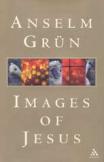See the Clown and More
From the time of the Devotio Moderna to the present, books offering guided meditations on Jesus have been a staple of Christian spirituality. Anselm Grün, a Benedictine monk and best-selling spiritual writer in Germany and throughout Europe, offers 50 short vignettes of the life and teaching of Jesus which provide wonderful material for prayer and reflection.
The images range from the traditional, The way, the truth and the life, to contemporary perspectives, Jesus as the drop-out, the vagabond or the family therapist. The author notes that the images grew out of spiritual conversations in the monastery about what Jesus means to people today, and describes them as an invitation to look with Jesus at our everyday conflicts, our problems at work and in the family, our anxieties and worries, our hopes and joys, and to deal with them fruitfully. The images are presented in a direct and readable style that almost disguises the author’s breadth of knowledge of the Patristic traditions and of the human sciences. After the reflection on each image, Grün offers helpful suggestions for prayer and reflection.
Since the work offers no systematic development or any attempt at a unified picture of Jesus, it is difficult to summarize, but a few examples may serve to capture its flavor. Reflecting on Jesus the teacher, Grün invites us to think of the Lord’s Prayer and the Sermon on the Mount in tandem, drawing on Augustine’s image of Christ as the teacher within. In Jesus the drop-out Grün reflects on the Markan statement that Jesus’ family thinks he is out of his mind (3:20). He considers Jesus’ experience as showing that the demands of the kingdom surpass deepest family tiesthat Jesus encourages us to go our own way, often in face of family expectation and to risk the loneliness that may open us to the mystery of God. The image of Jesus the vine (Jn. 15:1-13) not only symbolizes the intimacy between Jesus and the believer, but evokes the wine which gives life a new taste, and for John’s Greek readers would suggest the joy associated with Dionysiac festivals.
The different images do not offer a portrait of Jesus but an impressionistic mosaic. Grün’s Jesus is not distant but deeply engaged in the human condition, compassionate and caring. He assumes our humanity with all its strength and weaknesses, with its abysses and dangers, with its transitoriness and its mortality. Yet he challenges all pretense and misuse of power, and confronts the evil that corrupts the human heart, for example, in the love command by which Jesus does not leave us at peace with hostile stereotypes. My one regret is that the author did not reflect on some of those images that many people find especially disturbing, e.g., Jesus the fearful end-time judge (e.g. Mt 25:24-46), or the demanding overlord (Lk 17:5-10).
Today we constantly hear of people seeking help and guidance in prayer, often with the desire for more contact with the living Christ rather than institutional forms of piety. Grün’s images provide a supportive companion on people’s spiritual journey. One person might spend days on a particular image, while others can find a rich storehouse of things old and new to nurture their spiritual lives. I hope that more of Grün’s works will become available to the English-speaking world.
This article also appeared in print, under the headline “See the Clown and More,” in the April 21, 2003, issue.








